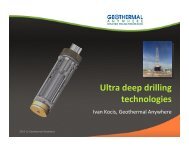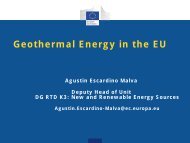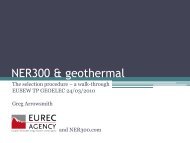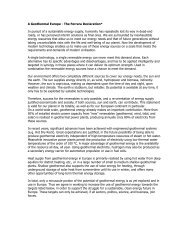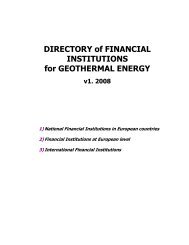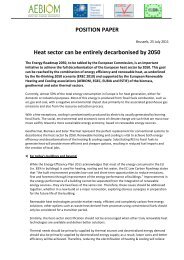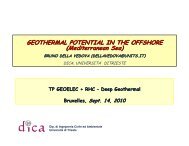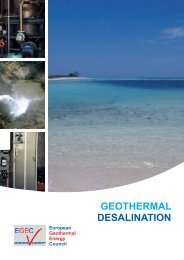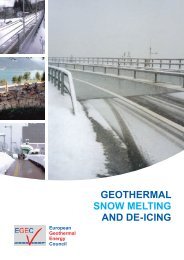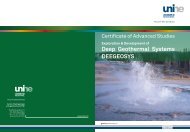Strategic Research and Innovation Agenda for Renewable ... - EGEC
Strategic Research and Innovation Agenda for Renewable ... - EGEC
Strategic Research and Innovation Agenda for Renewable ... - EGEC
You also want an ePaper? Increase the reach of your titles
YUMPU automatically turns print PDFs into web optimized ePapers that Google loves.
5<strong>Strategic</strong> <strong>Research</strong> <strong>and</strong> <strong>Innovation</strong> <strong>Agenda</strong> <strong>for</strong> <strong>Renewable</strong> Heating & CoolingRHC applications to industrial processes5.4.1 <strong>Research</strong> <strong>and</strong> innovation priorities with impact in the Short TermGEO.7 Geothermal Heat <strong>for</strong> industrial processes up to 250 °CObjectiveState-of-the-artTargetsType of activityInvestigations on the best match of geothermal heat sources (hydrothermal or EGS) to thespecific characteristics of industrial processes, <strong>and</strong> development of technology <strong>for</strong> practicaladaptation of geothermal heat to the industrial process.Improve desalination processes (e.g. on isl<strong>and</strong>s).Geothermal heat today is only used in some countries <strong>for</strong> drying processes <strong>for</strong> a number ofcommodities, including wood, fish, vegetables, etc. Other uses include heating in agriculture,horticulture <strong>and</strong> aquaculture.Make geothermal heat usable <strong>for</strong> industrial processes dem<strong>and</strong>ing medium-temperature heat;achieve a share of geothermal heat in industry of at least 20 % by 2050.50% Development / 50% DemonstrationGEO.8 Production pump technology <strong>for</strong> temperatures >180 °CObjectiveState-of-the-artTargetsType of activityCurrent LSP (line-shaft pump) <strong>and</strong> ESP (electric submersible pump) technology can achievetemperatures up to only 180°C. To reach temperatures closer to 250 °C, at the upper endof the medium temperature range, suitable ESP pumps need to be developed. These devicesare crucial <strong>for</strong> economic application of geothermal technologies in this temperature rangeof industrial heat.Submersible pumps today can work at maximum 180 °C <strong>and</strong> with a maximum flow rateof about 100 l/s.Commercially-available production pumps <strong>for</strong> high temperatures by 2020, as a prerequisiteto meeting the targets of GEO.1250% Development / 50% Demonstration5.4.2 <strong>Research</strong> <strong>and</strong> innovation priorities with impact in the Medium <strong>and</strong> Long TermGeothermal research <strong>and</strong> development activities whose impact will be mostly in the medium<strong>and</strong> long term focus mainly on EGS technology, unconventional resources (geopressurised,supercritical, ultra-deep) <strong>and</strong> on materials science. Also <strong>for</strong> re-injection of geothermal fluidsin certain geological conditions (e.g. some s<strong>and</strong>stone <strong>for</strong>mations) most probably more timewill be needed to develop satisfactory solutions. A specific priority is defined here:Unconventional resources <strong>and</strong> very high temperatures (GEO.9). This geothermal researchaims at making use of very high temperature resources above 250 °C. Projects like theIcel<strong>and</strong>ic Deep Drilling Programme investigate possibilities <strong>for</strong> extracting geothermalenergy up to 400 °C. Practical results <strong>and</strong> possible application here can be expected by 2030.<strong>Research</strong> <strong>and</strong> <strong>Innovation</strong> Priorities Predominant type of activity ImpactGEO.7 Geothermal Heat <strong>for</strong> industrial processes up to 250 °C Development / Demonstration By 2020GEO.8 Production pump technology <strong>for</strong> temperatures >180 °C Development / Demonstration By 2020GEO.9 Unconventional resources <strong>and</strong> very high temperatures <strong>Research</strong> By 2030Table 13: research <strong>and</strong> innovation priorities <strong>for</strong> geothermal applicationsto industrial processes5.5 Cross-cutting technologiesWithout advancements in cross-cutting technology, decarbonising the industrial heating <strong>and</strong>cooling dem<strong>and</strong> is likely to be more costly, less efficient <strong>and</strong> represent poorer valueto energy users at all scales. High <strong>and</strong> medium temperature heat networks servingindustrial clusters exploit economies of scale, mitigate investment risk <strong>and</strong> enableeconomic deployment of CHP technology.District Heating <strong>and</strong> Cooling systems should play an important role in future supplysystems to satisfy the industrial heat dem<strong>and</strong>. In this case, the potential <strong>for</strong> integrating heatinflow <strong>and</strong> outflow from different industries (also called heat cascading) emergeas key aspect. See Chapter 6 <strong>for</strong> details.56



